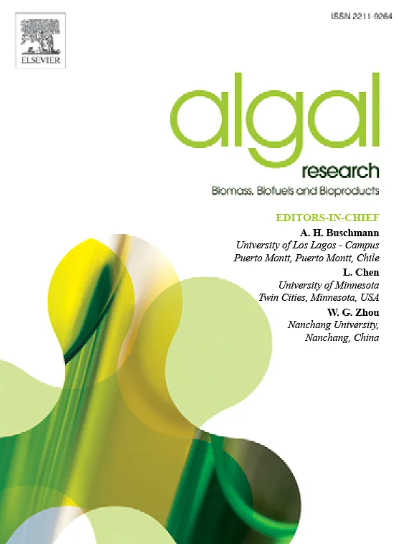Functional characterization of the recombinant L-type lectin from red alga Gracilaria fisheri with antibacterial potential
IF 4.6
2区 生物学
Q1 BIOTECHNOLOGY & APPLIED MICROBIOLOGY
Algal Research-Biomass Biofuels and Bioproducts
Pub Date : 2025-05-09
DOI:10.1016/j.algal.2025.104092
引用次数: 0
Abstract
Marine algal lectins are promising bioactive compounds with antimicrobial potential. This study produced and characterized a recombinant legume-type lectin from Gracilaria fisheri (rLGFL) and evaluated its antibacterial activity. The LGFL gene was cloned, sequence-verified, and expressed in Escherichia coli. Western blot analysis using a mouse polyclonal antiserum confirmed rLGFL expression. Functional assays demonstrated strong hemagglutination against rabbit erythrocytes, indicating carbohydrate recognition domain (CRD) functionality. rLGFL agglutinated Vibrio parahaemolyticus (3HP), Vibrio harveyi (1114), and Aeromonas veronii while exhibiting bactericidal activity against all tested pathogens, including non-agglutinated V. parahaemolyticus (A3212), Streptococcus agalactiae, Aeromonas hydrophila, and Edwardsiella ictaluri. These findings suggest dual antibacterial mechanisms: agglutination-mediated pathogen immobilization and direct bactericidal effects. Seasonal analysis of G. fisheri from Songkhla, Thailand, revealed peak LGFL expression from January to March and July to September, identifying optimal harvesting periods. This study highlights rLGFL as a potential eco-friendly antibacterial agent with applications in aquaculture and disease management.
具有抗菌潜力的红藻重组l型凝集素的功能表征
海藻凝集素是一种具有抗菌潜力的生物活性化合物。本研究从江蓠(Gracilaria fishi, rLGFL)中制备并鉴定了一种重组豆科植物凝集素,并对其抑菌活性进行了评价。克隆了LGFL基因,进行了序列验证,并在大肠杆菌中表达。小鼠多克隆抗血清Western blot分析证实rLGFL表达。功能分析显示对兔红细胞有很强的血凝作用,表明碳水化合物识别结构域(CRD)具有功能。rLGFL可凝集副溶血性弧菌(3HP)、哈维弧菌(1114)和维罗氏气单胞菌,同时对所有测试的病原体,包括非凝集副溶血性弧菌(A3212)、无乳链球菌、嗜水气单胞菌和爱德华氏菌均有杀菌活性。这些发现提示双重抗菌机制:凝集介导的病原体固定化和直接杀菌作用。对产自泰国宋卡(Songkhla)的G. fishi进行季节分析,发现LGFL表达高峰在1 - 3月和7 - 9月,确定了最佳采收期。本研究强调了rLGFL作为一种潜在的生态友好型抗菌剂在水产养殖和疾病管理方面的应用前景。
本文章由计算机程序翻译,如有差异,请以英文原文为准。
求助全文
约1分钟内获得全文
求助全文
来源期刊

Algal Research-Biomass Biofuels and Bioproducts
BIOTECHNOLOGY & APPLIED MICROBIOLOGY-
CiteScore
9.40
自引率
7.80%
发文量
332
期刊介绍:
Algal Research is an international phycology journal covering all areas of emerging technologies in algae biology, biomass production, cultivation, harvesting, extraction, bioproducts, biorefinery, engineering, and econometrics. Algae is defined to include cyanobacteria, microalgae, and protists and symbionts of interest in biotechnology. The journal publishes original research and reviews for the following scope: algal biology, including but not exclusive to: phylogeny, biodiversity, molecular traits, metabolic regulation, and genetic engineering, algal cultivation, e.g. phototrophic systems, heterotrophic systems, and mixotrophic systems, algal harvesting and extraction systems, biotechnology to convert algal biomass and components into biofuels and bioproducts, e.g., nutraceuticals, pharmaceuticals, animal feed, plastics, etc. algal products and their economic assessment
 求助内容:
求助内容: 应助结果提醒方式:
应助结果提醒方式:


